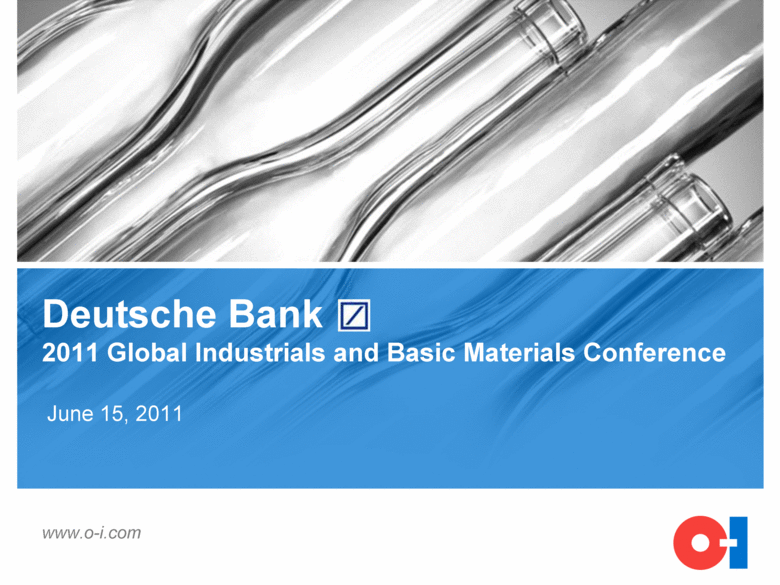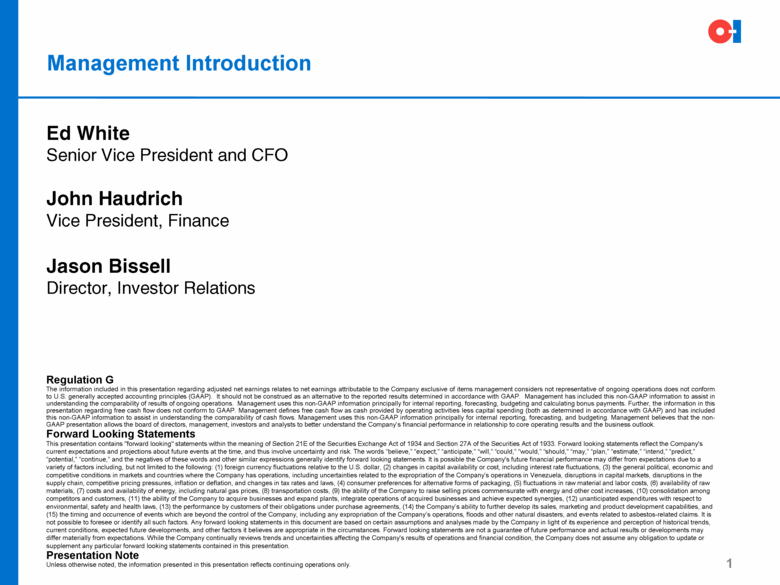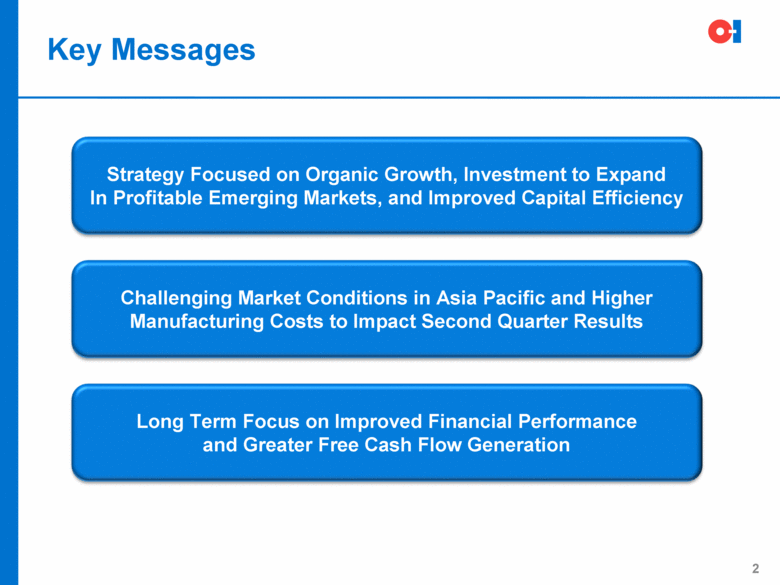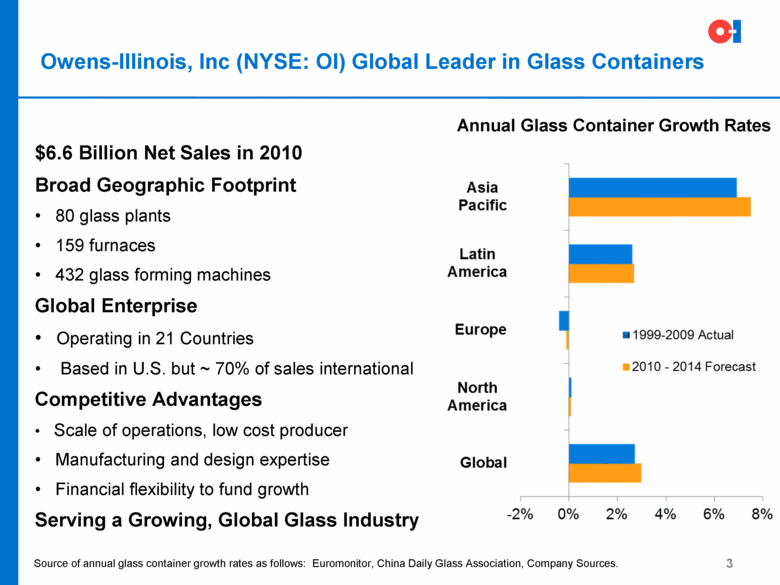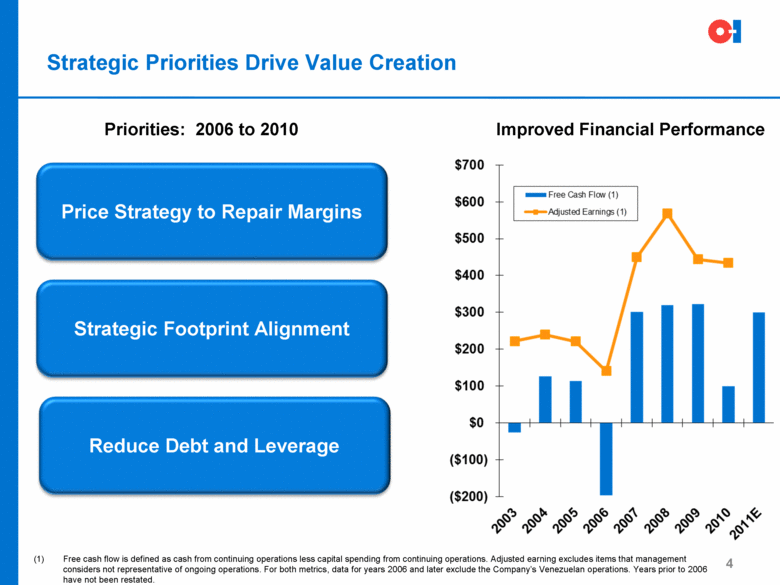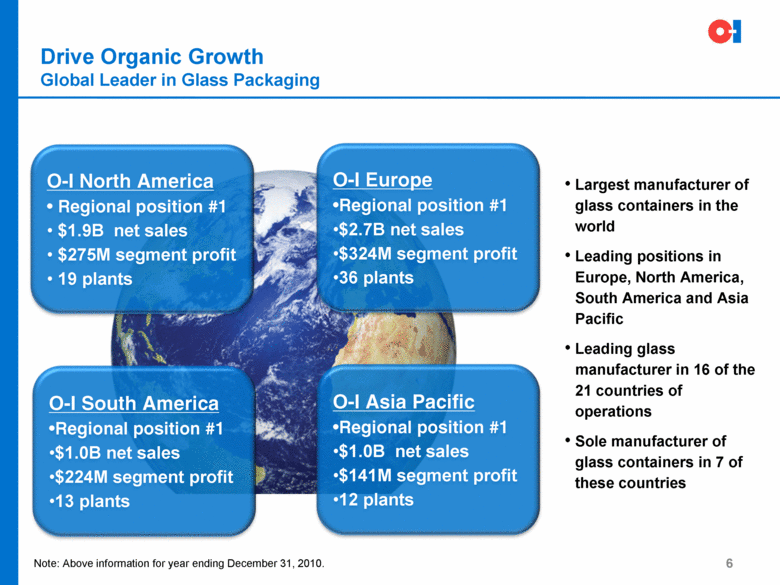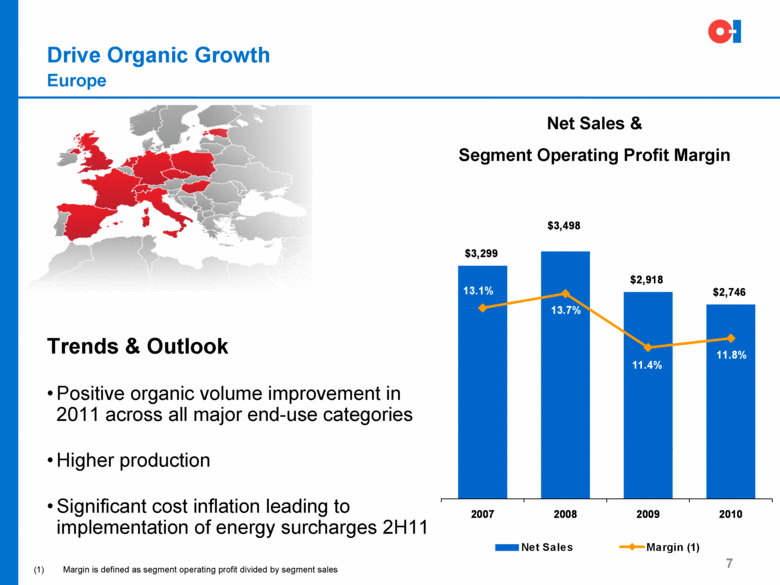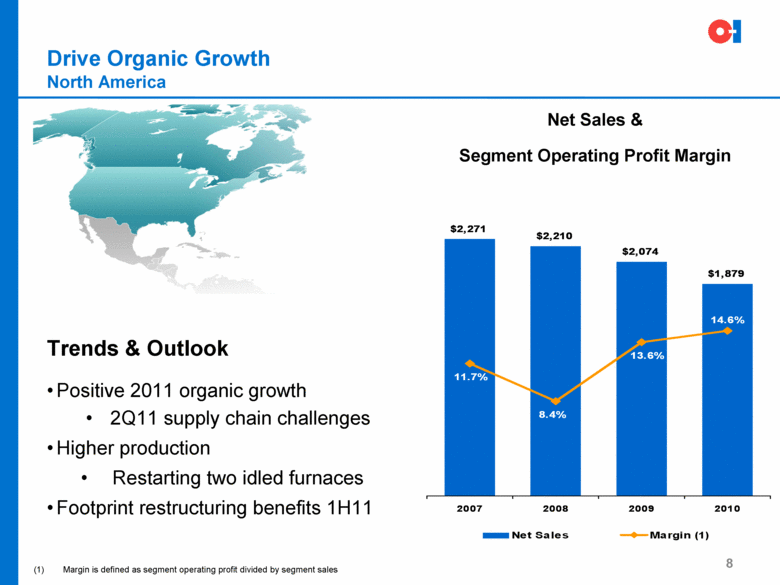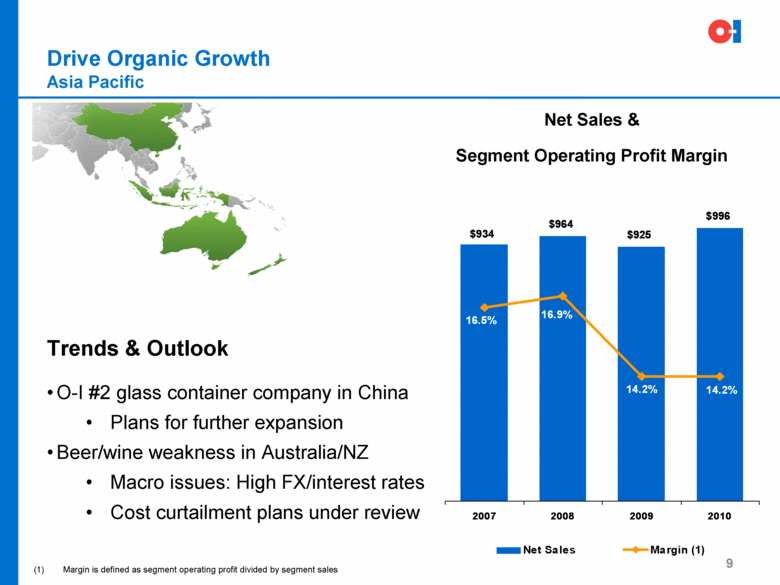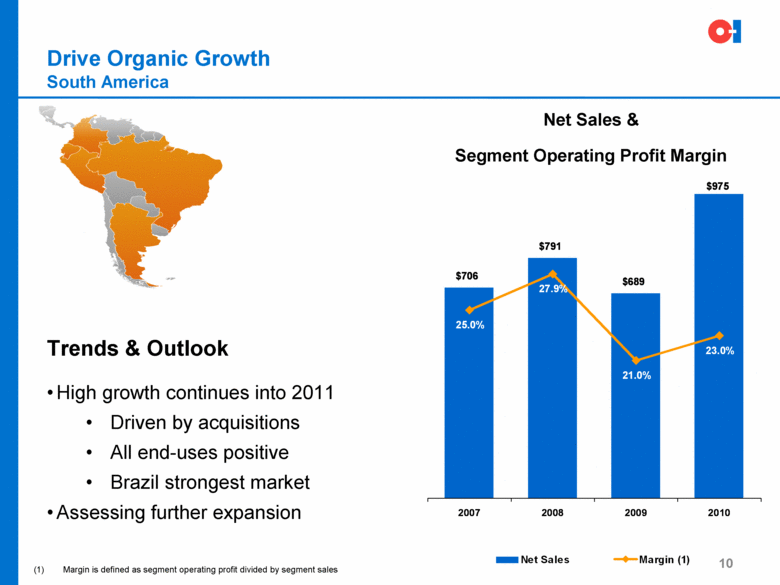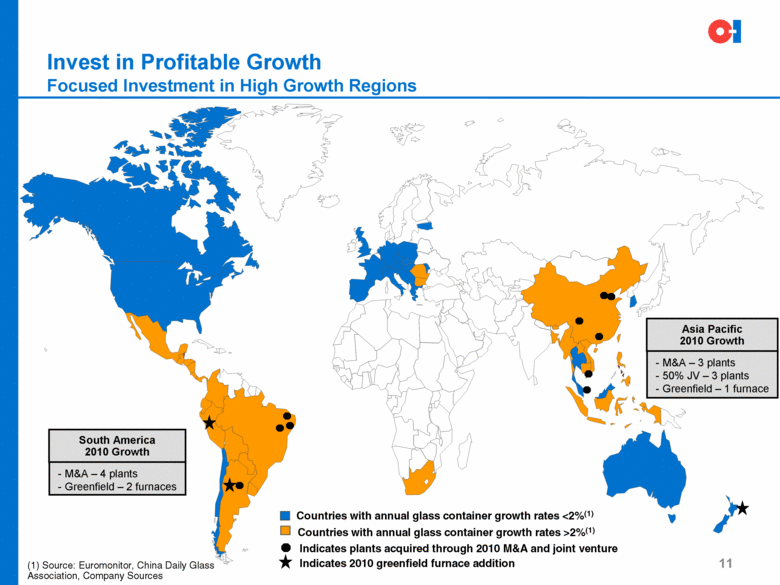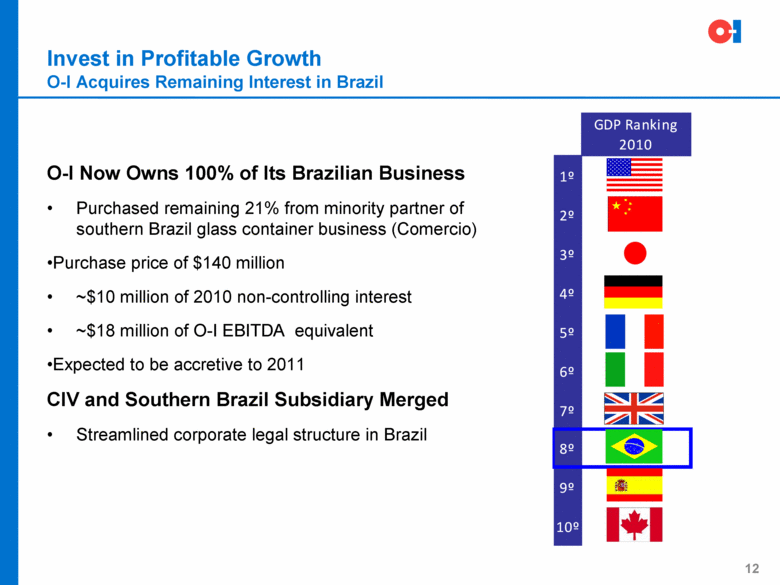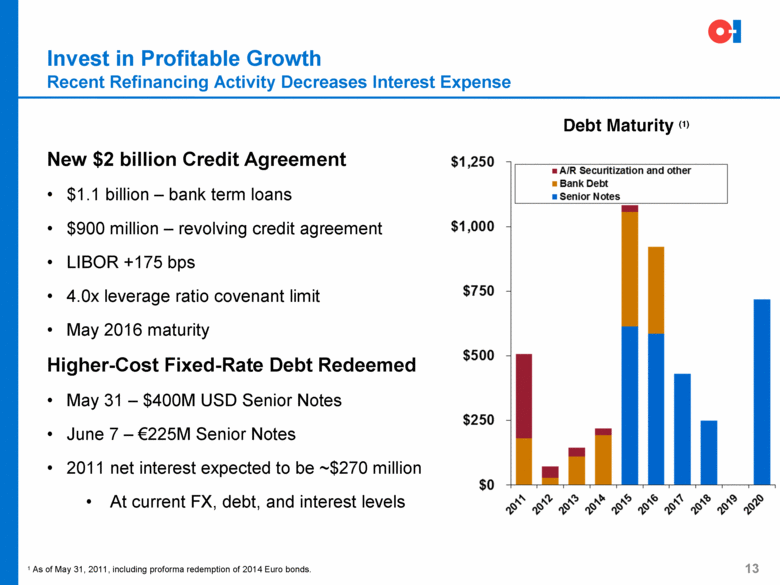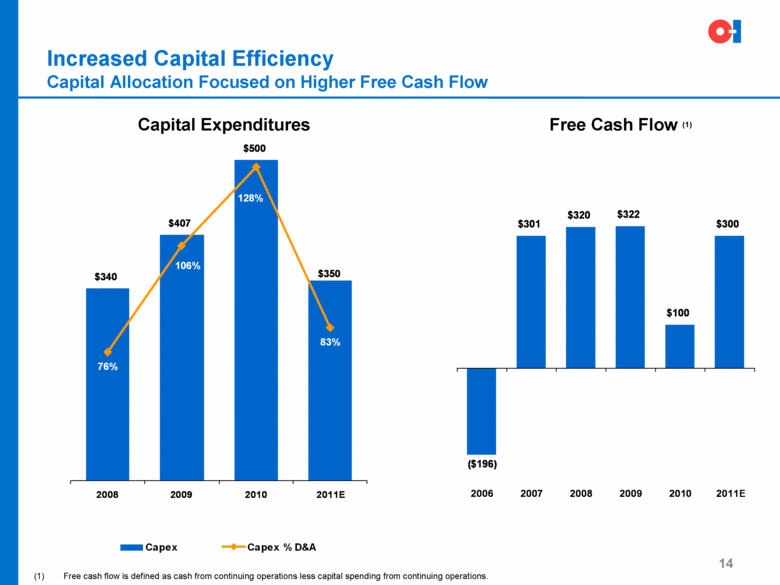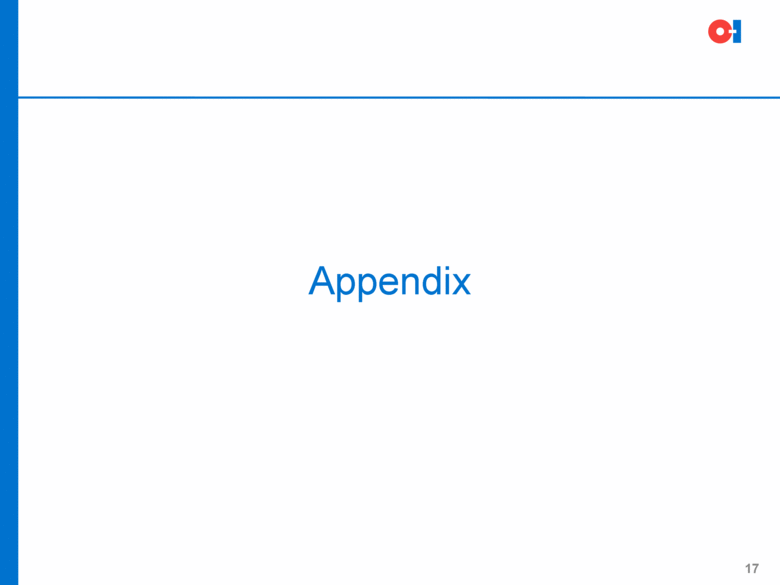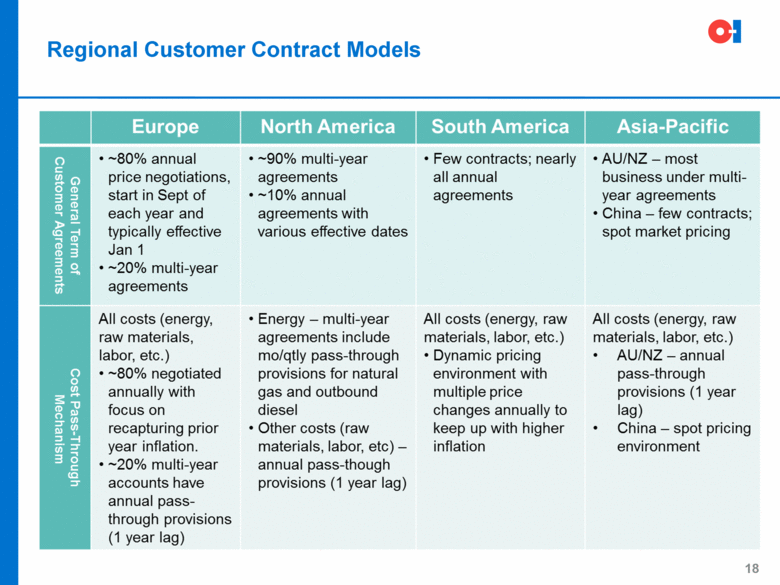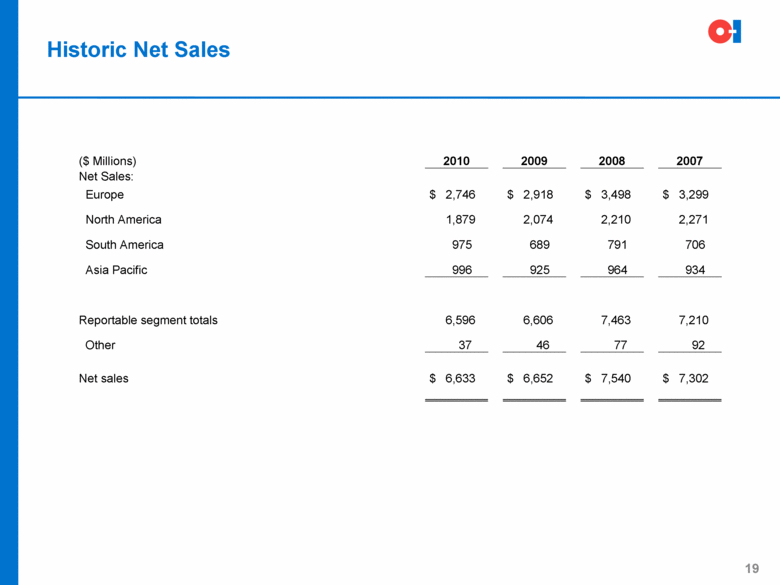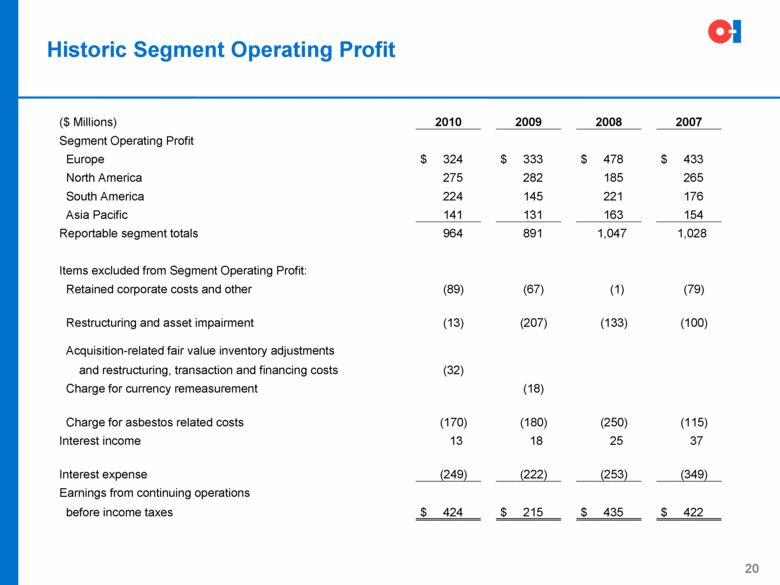Attached files
| file | filename |
|---|---|
| 8-K - 8-K - O-I Glass, Inc. /DE/ | a11-14945_18k.htm |
| EX-99.1 - EX-99.1 - O-I Glass, Inc. /DE/ | a11-14945_1ex99d1.htm |
Exhibit 99.2
|
|
Deutsche Bank 2011 Global Industrials and Basic Materials Conference June 15, 2011 |
|
|
1 Management Introduction Ed White Senior Vice President and CFO John Haudrich Vice President, Finance Jason Bissell Director, Investor Relations Regulation G The information included in this presentation regarding adjusted net earnings relates to net earnings attributable to the Company exclusive of items management considers not representative of ongoing operations does not conform to U.S. generally accepted accounting principles (GAAP). It should not be construed as an alternative to the reported results determined in accordance with GAAP. Management has included this non-GAAP information to assist in understanding the comparability of results of ongoing operations. Management uses this non-GAAP information principally for internal reporting, forecasting, budgeting and calculating bonus payments. Further, the information in this presentation regarding free cash flow does not conform to GAAP. Management defines free cash flow as cash provided by operating activities less capital spending (both as determined in accordance with GAAP) and has included this non-GAAP information to assist in understanding the comparability of cash flows. Management uses this non-GAAP information principally for internal reporting, forecasting, and budgeting. Management believes that the non-GAAP presentation allows the board of directors, management, investors and analysts to better understand the Company’s financial performance in relationship to core operating results and the business outlook. Forward Looking Statements This presentation contains "forward looking" statements within the meaning of Section 21E of the Securities Exchange Act of 1934 and Section 27A of the Securities Act of 1933. Forward looking statements reflect the Company's current expectations and projections about future events at the time, and thus involve uncertainty and risk. The words “believe,” “expect,” “anticipate,” “will,” “could,” “would,” “should,” “may,” “plan,” “estimate,” “intend,” “predict,” “potential,” “continue,” and the negatives of these words and other similar expressions generally identify forward looking statements. It is possible the Company's future financial performance may differ from expectations due to a variety of factors including, but not limited to the following: (1) foreign currency fluctuations relative to the U.S. dollar, (2) changes in capital availability or cost, including interest rate fluctuations, (3) the general political, economic and competitive conditions in markets and countries where the Company has operations, including uncertainties related to the expropriation of the Company’s operations in Venezuela, disruptions in capital markets, disruptions in the supply chain, competitive pricing pressures, inflation or deflation, and changes in tax rates and laws, (4) consumer preferences for alternative forms of packaging, (5) fluctuations in raw material and labor costs, (6) availability of raw materials, (7) costs and availability of energy, including natural gas prices, (8) transportation costs, (9) the ability of the Company to raise selling prices commensurate with energy and other cost increases, (10) consolidation among competitors and customers, (11) the ability of the Company to acquire businesses and expand plants, integrate operations of acquired businesses and achieve expected synergies, (12) unanticipated expenditures with respect to environmental, safety and health laws, (13) the performance by customers of their obligations under purchase agreements, (14) the Company’s ability to further develop its sales, marketing and product development capabilities, and (15) the timing and occurrence of events which are beyond the control of the Company, including any expropriation of the Company’s operations, floods and other natural disasters, and events related to asbestos-related claims. It is not possible to foresee or identify all such factors. Any forward looking statements in this document are based on certain assumptions and analyses made by the Company in light of its experience and perception of historical trends, current conditions, expected future developments, and other factors it believes are appropriate in the circumstances. Forward looking statements are not a guarantee of future performance and actual results or developments may differ materially from expectations. While the Company continually reviews trends and uncertainties affecting the Company's results of operations and financial condition, the Company does not assume any obligation to update or supplement any particular forward looking statements contained in this presentation. Presentation Note Unless otherwise noted, the information presented in this presentation reflects continuing operations only. |
|
|
Key Messages 2 Strategy Focused on Organic Growth, Investment to Expand In Profitable Emerging Markets, and Improved Capital Efficiency Long Term Focus on Improved Financial Performance and Greater Free Cash Flow Generation Challenging Market Conditions in Asia Pacific and Higher Manufacturing Costs to Impact Second Quarter Results |
|
|
3 Owens-Illinois, Inc (NYSE: OI) Global Leader in Glass Containers $6.6 Billion Net Sales in 2010 Broad Geographic Footprint 80 glass plants 159 furnaces 432 glass forming machines Global Enterprise Operating in 21 Countries Based in U.S. but ~ 70% of sales international Competitive Advantages Scale of operations, low cost producer Manufacturing and design expertise Financial flexibility to fund growth Serving a Growing, Global Glass Industry Source of annual glass container growth rates as follows: Euromonitor, China Daily Glass Association, Company Sources. Annual Glass Container Growth Rates |
|
|
4 Strategic Priorities Drive Value Creation Free cash flow is defined as cash from continuing operations less capital spending from continuing operations. Adjusted earning excludes items that management considers not representative of ongoing operations. For both metrics, data for years 2006 and later exclude the Company’s Venezuelan operations. Years prior to 2006 have not been restated. Improved Financial Performance Priorities: 2006 to 2010 Price Strategy to Repair Margins Strategic Footprint Alignment Reduce Debt and Leverage |
|
|
5 Priorities to Improve Shareholder Value Drive Organic Growth Improve Top-line Operating Excellence Invest in Profitable Growth Emerging Markets & High Return Projects Healthy Balance Sheet Increased Capital Efficiency Strong Free Cash Flow |
|
|
6 Largest manufacturer of glass containers in the world Leading positions in Europe, North America, South America and Asia Pacific Leading glass manufacturer in 16 of the 21 countries of operations Sole manufacturer of glass containers in 7 of these countries Drive Organic Growth Global Leader in Glass Packaging Note: Above information for year ending December 31, 2010. O-I North America Regional position #1 $1.9B net sales $275M segment profit 19 plants O-I Europe Regional position #1 $2.7B net sales $324M segment profit 36 plants O-I South America Regional position #1 $1.0B net sales $224M segment profit 13 plants O-I Asia Pacific Regional position #1 $1.0B net sales $141M segment profit 12 plants |
|
|
7 Trends & Outlook Positive organic volume improvement in 2011 across all major end-use categories Higher production Significant cost inflation leading to implementation of energy surcharges 2H11 Drive Organic Growth Europe Net Sales & Segment Operating Profit Margin Margin is defined as segment operating profit divided by segment sales $3,299 $2,918 $2,746 $3,498 13.7% 11.8% 11.4% 13.1% 2007 2008 2009 2010 Net Sales Margin (1) |
|
|
8 Drive Organic Growth North America Trends & Outlook Positive 2011 organic growth 2Q11 supply chain challenges Higher production Restarting two idled furnaces Footprint restructuring benefits 1H11 Net Sales & Segment Operating Profit Margin Margin is defined as segment operating profit divided by segment sales $2,271 $2,210 $2,074 $1,879 14.6% 8.4% 13.6% 11.7% 2007 2008 2009 2010 Net Sales Margin (1) |
|
|
9 Drive Organic Growth Asia Pacific Trends & Outlook O-I #2 glass container company in China Plans for further expansion Beer/wine weakness in Australia/NZ Macro issues: High FX/interest rates Cost curtailment plans under review Net Sales & Segment Operating Profit Margin Margin is defined as segment operating profit divided by segment sales $964 $925 $996 $934 16.9% 14.2% 14.2% 16.5% 2007 2008 2009 2010 Net Sales Margin (1) |
|
|
10 Drive Organic Growth South America Trends & Outlook High growth continues into 2011 Driven by acquisitions All end-uses positive Brazil strongest market Assessing further expansion Margin is defined as segment operating profit divided by segment sales Net Sales & Segment Operating Profit Margin $706 $791 $689 $975 23.0% 27.9% 21.0% 25.0% 2007 2008 2009 2010 Net Sales Margin (1) |
|
|
11 (1) Source: Euromonitor, China Daily Glass Association, Company Sources Invest in Profitable Growth Focused Investment in High Growth Regions Asia Pacific 2010 Growth - M&A – 3 plants - 50% JV – 3 plants - Greenfield – 1 furnace South America 2010 Growth - M&A – 4 plants - Greenfield – 2 furnaces Countries with annual glass container growth rates <2%(1) Countries with annual glass container growth rates >2%(1) Indicates plants acquired through 2010 M&A and joint venture Indicates 2010 greenfield furnace addition |
|
|
Invest in Profitable Growth O-I Acquires Remaining Interest in Brazil O-I Now Owns 100% of Its Brazilian Business Purchased remaining 21% from minority partner of southern Brazil glass container business (Comercio) Purchase price of $140 million ~$10 million of 2010 non-controlling interest ~$18 million of O-I EBITDA equivalent Expected to be accretive to 2011 CIV and Southern Brazil Subsidiary Merged Streamlined corporate legal structure in Brazil 12 |
|
|
Invest in Profitable Growth Recent Refinancing Activity Decreases Interest Expense New $2 billion Credit Agreement $1.1 billion – bank term loans $900 million – revolving credit agreement LIBOR +175 bps 4.0x leverage ratio covenant limit May 2016 maturity Higher-Cost Fixed-Rate Debt Redeemed May 31 – $400M USD Senior Notes June 7 – €225M Senior Notes 2011 net interest expected to be ~$270 million At current FX, debt, and interest levels 13 Debt Maturity (1) 1 As of May 31, 2011, including proforma redemption of 2014 Euro bonds. |
|
|
14 Increased Capital Efficiency Capital Allocation Focused on Higher Free Cash Flow Free Cash Flow (1) Free cash flow is defined as cash from continuing operations less capital spending from continuing operations. Capital Expenditures $301 $320 $322 $100 $300 ($196) 2006 2007 2008 2009 2010 2011E $340 $407 $500 $350 83% 106% 128% 76% 2008 2009 2010 2011E Capex Capex % D&A |
|
|
2Q11 Business Update Challenging Market Conditions in Asia Pacific and Higher Manufacturing and Delivery Costs to Impact Second Quarter Results 15 2Q11 vs 2Q10 2Q11 Trends Since Last Conference Call Net Income Adjusted Earnings Benefits of higher YoY volume offset by greater costs Segment Profit Europe No significant changes North America Supply chain and production inefficiencies Incremental manufacturing and delivery costs Asia Pacific Weaker demand in Australia and New Zealand Higher costs due to lower production South America Continued high freight costs to support Brazil growth Non-Operational Corporate and Other Costs Lower than expected other costs, revised estimates: Corporate costs ~ $15 to $20M Non-controlling interest ~ $8 to $10M Effective tax rate 23% to 24% in 2Q11, ~25% full yr Favorable / Unfavorable Impact on Earnings |
|
|
16 Concluding Comments Drive Organic Growth Volume: + 5 to 10% in 2011 Invest in Profitable Growth Emerging Markets & High Return Projects < 3x Net Debt/EBITDA Increased Capital Efficiency ~ $350M Capex in 2011 ~ $300M Free Cash Flow in 2011 |
|
|
Appendix 17 |
|
|
Regional Customer Contract Models 18 |
|
|
Historic Net Sales 19 ($ Millions) 2010 2009 2008 2007 Net Sales: Europe $ 2,746 $ 2,918 $ 3,498 $ 3,299 North America 1,879 2,074 2,210 2,271 South America 975 689 791 706 Asia Pacific 996 925 964 934 Reportable segment totals 6,596 6,606 7,463 7,210 Other 37 46 77 92 Net sales $ 6,633 $ 6,652 $ 7,540 $ 7,302 |
|
|
Historic Segment Operating Profit 20 ($ Millions) 2010 2009 2008 2007 Segment Operating Profit Europe $ 324 $ 333 $ 478 $ 433 North America 275 282 185 265 South America 224 145 221 176 Asia Pacific 141 131 163 154 Reportable segment totals 964 891 1,047 1,028 Items excluded from Segment Operating Profit: Retained corporate costs and other (89) (67) (1) (79) Restructuring and asset impairment (13) (207) (133) (100) Acquisition-related fair value inventory adjustments and restructuring, transaction and financing costs (32) Charge for currency remeasurement (18) Charge for asbestos related costs (170) (180) (250) (115) Interest income 13 18 25 37 Interest expense (249) (222) (253) (349) Earnings from continuing operations before income taxes $ 424 $ 215 $ 435 $ 422 |

